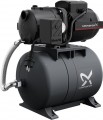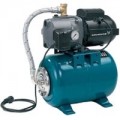Max. pressure
The highest pressure that the pump is capable of creating during operation. This parameter is directly related to the maximum head (see above); however, it is less obvious, and therefore, it is indicated rarely.
Suction height
The largest difference between the height of the pump and the height of the water level at which the pump can provide normal suction. Without special devices, the maximum value of this parameter is 7-8 m — this is due to the physics of the process. However, when using an ejector (see below), the suction height can be increased several times.
Maximum liquid temperature
The highest temperature of water at which the pump is capable of operating normally. Usually, in most models this parameter is 35-40 °C — at high temperatures it is difficult to ensure effective cooling of the engine and moving parts, and in fact, such conditions are rare.
Volume of water pressure tank
The volume of the water pressure tank provided in the design of the pressure tank unit.
A water pressure tank is a reservoir capable of holding a certain volume of water. It performs several functions at once. The main ones are: firstly, maintaining a stable pressure; secondly, protection against water hammer; and thirdly, storage of an “emergency” supply of water in case of a power outage, pump breakdown, etc. The larger the volume of this tank, the better it handles its capabilities; on the other hand, a large capacity significantly affects the dimensions and cost of the tank. Therefore, it does not always make sense to look for a pump with the maximum volume of the water pressure tank. Specific recommendations on choosing the optimal volume for different situations can be found in special sources.
Noise level
The noise level produced by the pump during normal operation. For comparison, 50 decibels roughly corresponds to the noise in an office room, 60 dB to an average TV volume, 70 dB to a truck at a distance of about 8 m, 80 dB to traffic noise, and 90 dB to a scream. The lower the noise level, the more comfortable the use of the pump and the closer it can be placed to people. This parameter is especially important for models designed for indoor installation.
Protection class (IP)
An indicator that determines the degree of protection of dangerous (moving and current-carrying) parts of the hardware of the pump from adverse effects, namely solid objects and water. Since pumps, by definition, are used for pumping liquids, and many of them can normally pass quite large particles, in this case, we are talking about protection against moisture and foreign objects from outside.
The level of protection is usually indicated by a marking of the letters IP and two numbers, the first of which indicates protection against the effects of solid objects, and the second — against the ingress of water.
For the first digit, each value corresponds to the following protection values: 1 — protection against objects with a diameter of more than 50 mm (large body surfaces) 2 — against objects with a diameter of more than 12.5 mm (fingers, etc.) 3 — against objects more than 2.5 mm (most tools) 4 — against objects larger than 1 mm (virtually all tools, most wires) 5 — dust-proof (total protection against contact; dust can enter, but does not affect the operation of the device) 6 — dust-proof (case with full dust protection and contact).
For the second digit: 1 — protection against vertically falling drops of water 2 — against drops of water with a deviation of up to 15° from the vertical axis of the device 3 — against drops of water with a deviation of up to 60° from the vertical axis of the device (rain) 4 — against splashes from any direct...ion 5 — from jets from any direction 6 — from sea waves or strong water jets 7 — short-term immersion to a depth of up to 1 m (without the possibility of continuous operation in immersed mode) 8 — long-term immersion to a depth of more than 1 m (with the possibility of permanent operation) in immersed mode).
Note that in some cases one of the numbers can be replaced by the letter X — this means that official certification for the corresponding parameter has not been carried out. In pumps, X is usually put in place of the first digit, because. a high degree of moisture resistance (and for submersible models, for example, it must, by definition, correspond to 8) means a high degree of protection against solid contaminants.
Water pressure tank material
The material of the water pressure tank provided in the design of the pumping station.
Recall that the classic (not sewer) pumping station is a surface pump, supplemented by a water pressure tank. Such a tank is a reservoir where water accumulates. It performs two functions: it smooths out pressure drops in the system and stores some water in case the pump is turned off. For the main body in such containers, the following materials can be used:
— Cast iron. The simplest and most inexpensive option: cast iron is somewhat inferior to stainless steel in terms of strength and corrosion resistance. However, for those models in which it is used, these moments do not have a noticeable meaning.
— Stainless steel. The most advanced material in use: stainless steel combines high strength and corrosion resistance. However, such tanks are somewhat more expensive than other varieties.
— Steel. Non-stainless steel accumulators usually use special coatings to protect against corrosion. This material is superior to cast iron in strength and is somewhat cheaper than stainless steel.
— Aluminium. The main advantage of aluminium alloys is their light weight combined with quite decent strength and rust resistance. Of the shortcomings, a rather high price can be noted.

